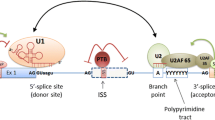Abstract.
The amelogenins, the major proteins of the developing tooth enamel matrix, are highly conserved throughout most species studied. The gene structure is similar, with a set of seven exons and intervening introns, and remarkable conservation of particular exon sizes over divergent species. Studies of exon skipping and consequent alternative gene splicing suggest that, in vertebrates, exon definition is crucial. In this mechanism, exon size is important. If too small, an exon can be readily skipped, if too large, internal cryptic splice sites may be utilized. Other factors, such as intron length and specific nucleotide sequences at the splice boundaries also modulate splicing efficiency, but amelogenin gene splicing conforms well to the generalized exon length model. Exons 1, 2 and 7 are not subject to splicing that affects the secreted protein product, but exons 3, 4 and 5 are at the lower boundary of exon size, rendering them, 4 and 5 especially, subject to skipping. On the other hand, exon 6 is very long and has cryptic splicing sites that can be used. In the mouse, nine distinct splice product proteins have been detected. The question now is the functions of these products. The larger forms, those that contain the intact proline-rich, hydrophobic exon 6 domains, are important for enamel mineralization. Recent work suggests that the small proteins resulting from deletion of a major part of amelogenin gene exon 6 via utilization of a cryptic site may have signal transduction functions during tooth development. Furthermore, new work also suggests that odontoblasts transiently express the small amelogenins during the period that epithelial-mesenchymal signaling between preodontoblasts and preameloblasts determines the course of tooth development. The same peptides have been demonstrated to act on non-odontogenic cells and effect their phenotypic expression patterns in vitro, and to induce bone formation in implants in vivo.
Similar content being viewed by others
Author information
Authors and Affiliations
Additional information
Received 20 March 2002; received after revision 2 July 2002; accepted 3 July 2002
Rights and permissions
About this article
Cite this article
Veis, A. Amelogenin gene splice products: potential signaling molecules. CMLS, Cell. Mol. Life Sci. 60, 38–55 (2003). https://doi.org/10.1007/s000180300003
Issue Date:
DOI: https://doi.org/10.1007/s000180300003




